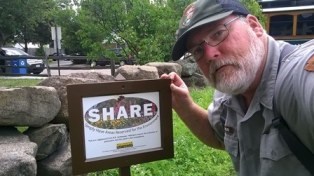
Saving Our Planet: One Action At A Time Adams National Historical Park Maintenance Worker, Chris Blood, was as busy as a bee promoting National Pollinator Week, June 15 - 21, 2015. Passionate in his work and caring deeply about the health of our planet, Chris initiated and oversees the park's successful recycling program. When he learned about the Pollinator Partnership Program to protect pollinator populations, he continued on his quest to make a difference. The following questions are part of an interview conducted with Chris. Question: How did you first learn about the issues relating to pollinators like bees and butterflies? Chris: I learned about pollinators when I started working with the gardener here, Bob Mackenzie. He was advocating for the limited and careful use of all pesticides in the work we do at Adams National Historical Park. He was concerned about the impact of pesticide use on the environment, including pollinators. In my career with the National Park Service (NPS) I have had the opportunity to attend several landscape and gardening training classes, sponsored by the NPS and the Olmsted Center for Landscape Preservation. A key message in every class is the importance of promoting sustainable, “pollinator friendly “practices in the work we do. Question: How did you find out about the Pollinator Partnership Program? Chris: I recently joined the Massachusetts Horticulture Society and visited their headquarters and gardens at Elm Bank, in Wellesley, MA. When I arrived, I was given a package of Burpee Bee Garden wildflower seeds as a welcome gift. The back of the package included information about the President’s National Pollinator Initiative. I learned that, along with the White House, the Department of Interior and Department of Agriculture partnered with the Burpee seed company and the non-profit Pollinator Partnership to increase awareness about the dramatic decrease of pollinators around the world. Question: What are you doing to increase public awareness of the National Pollinator Initiative? Chris: Adams National Historical Park is registered as a S.H.A.R.E site (Simply Have Areas Reserved for the Environment) www.pollinator.org/SHARE. In addition to the historic garden at the Old House at Peace field, we have planted two wildflower beds, one at the John Adams and John Quincy Adams Birthplaces and a second at park headquarters. These flowers are attractive to bees and butterflies. We have marked the flower beds with S.H.A.R.E. signs we received from the Pollinator Partnership Program. These signs draw attention to the Pollinator Partnership Program and inform people that they too can register their home or business wildflower beds and be a part of this Nationwide Pollinator initiative Question: What would you like to share with the people about what they can do to help our pollinator friends? Chris: First, if the use of pesticides is necessary, I would encourage people to use any pesticides very sparingly and to carefully follow the directions on the label. Secondly, I want people to know that pollinators are not only attracted to formal flower beds, but also to wildflowers that grow throughout the landscape. This includes what some might describe as a weed, such as dandelions and clover. This is a pollinator's salad! I know some of these plants can be unsightly, but if they are in an area that can be left until the blooms are gone, it will benefit the bees and butterflies. Finally, get out and plant, and be sure to encourage your neighbors to do the same! C2A 5,7,22,23
|
Last updated: July 9, 2015
